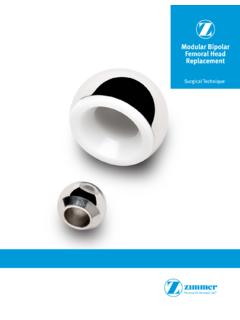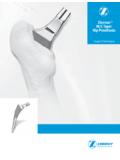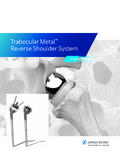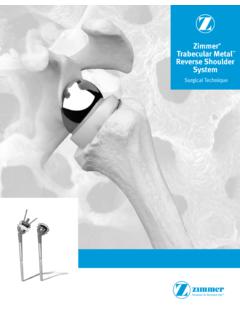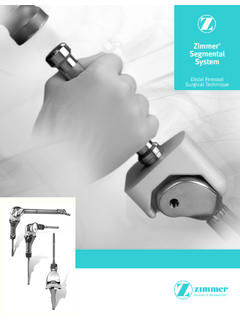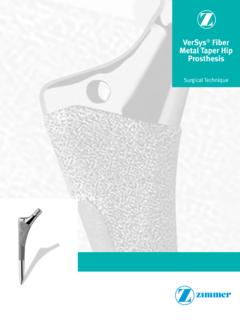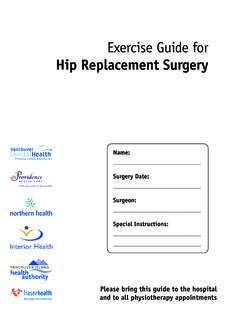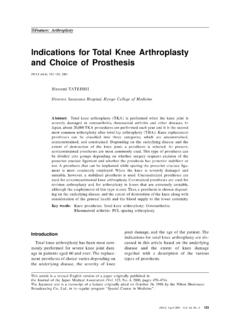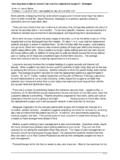Transcription of Persona The Personalized Knee - Zimmer Biomet
1 Persona . The Personalized knee surgical technique Table of Contents 2. Constraint Options Preoperative Planning surgical Approach Patient Preparation Magnet Usage Symbols Screw/Pin Information Resect Distal 6. Assemble Adjustable Distal Resection Instrumentation Establish Femoral Alignment Resect Distal Femur Optional Instrument Optional Cutting technique Resect Proximal 12. Assemble Extramedullary (EM) Alignment Guide Position Alignment Guide Set Resection Level Resect Proximal Tibia Optional technique Size Femur and Establish External 19. Complete Femoral A/P and Chamfer 22. Optional Instrument Establish Size and Rotation of 24. Drill and Broach 25. Optional technique Prepare the 28. Resect the 28. Finish the 29. CR Femoral Finishing and 31. PS Femoral Finishing and PS Box 33. Perform Trial 38. Table of Contents (cont.). Tibial Articular Surface Provisional (TASP) 39. Implant 43. Tibial Plate Femoral Component Bearing Patellar Component All-Polyethylene Patella Close 46.
2 Surgeon Notes and Tips Appendix 47. 2 Degrees Valgus Recut Guide 2 Degrees Varus Recut Guide Appendix 49. Spacer Block technique Appendix C: Optional 52. Resect Distal Femur: Fixed Distal Resection Instrument Size Femur - Anterior Referencing Sizer Shift Block Resect Distal Femur - PRI Distal Resection Instrument Implant Components - Attached Tibial Plate Inserter Appendix 66. Compatibility Charts surgical technique 2 | Persona The Personalized knee surgical technique Introduction Successful total knee arthroplasty depends in part on The CR femoral provisionals and components can re-establishment of normal lower extremity alignment, be used when the PCL is sacrificed or deficient and proper implant design and orientation, secure implant removed, if used with either a MC or ultracongruent fixation, and adequate soft tissue balancing and (UC) bearing provisionals and components. stability. Persona The Personalized knee is designed to help the surgeon accomplish these goals by combining Also, posterior stabilized (PS) femoral provisionals and alignment accuracy with a simple, straight-forward components can be used with the PS or constrained technique .
3 Posterior stabilized (CPS) bearings provisionals and components when the PCL is deficient and removed. T he instruments and technique assist the surgeon in restoring the center of the hip, knee , and ankle to lie PS femoral components cannot be used with CR, MC, in a straight line, establishing a neutral mechanical or UC bearings and CR femoral components cannot be axis. The femoral and tibial components are used with PS or CPS bearings. oriented perpendicular to this axis. Femoral rotation The CPS bearings can be used to provide moderate is determined using the posterior condyles, the varus\valgus constraint in patients to facilitate soft epicondylar axis, or Whiteside's line as a reference. tissue balance and stability. The CPS bearings shall The instruments enable accurate cuts to ensure robust be used with cemented non-porous femoral and tibial component fixation. components only. Additional information for this A wide variety of component sizes, shapes, and product may be found in the Constrained Posterior constraint options allow for optimized component fit Stabilized (CPS) surgical technique (97-5026-072-00).
4 And soft tissue balancing. The femur, tibia, and patella The MC, UC, PS, and CPS implants can be used in are prepared independently, and can be cut in any the following situations, depending on the degree sequence using the principle of measured resection of the deformity, the stability of the ligaments, and (removing enough bone to allow replacement by the the quality of the bone. The surgeon is responsible prosthesis). Adjustment cuts may be needed later. The for assessing whether a more constraining implant/. anterior referencing technique uses the anterior cortex system or revision implant/system is necessary. to set the A/P position of the femoral component. The posterior condyle cut is variable. Marked valgus deformity requiring PCL. 1.. and lateral soft tissue release. Constraint Options 2. Prior high tibial osteotomies soft tissue balancing is the same as for a valgus deformity The degree of constraint of the bearing can be with lateral soft tissue and PCL release.
5 Planned based on surgeon preference and patient requirements. The use of the cruciate retaining (CR) 3. Patellectomy PCL incomplete or absent. femoral provisionals and components can be used with either a CR or Medial Congruent (MC) bearing when 4. Most revision situations PCL deficient the posterior cruciate ligament (PCL) is intact. or nonfunctional. 3 | Persona The Personalized knee surgical technique Introduction (cont.). Patient Preparation Note: The MC components can be used with or To prepare the limb for total knee arthroplasty, without the PCL present. The UC, PS, and CPS adequate muscle relaxation is required. The components should not be used if the PCL is anesthesiologist should adjust the medication based present. on the patient's habitus and weight, and administer to induce adequate muscle paralysis for a minimum Please refer to the package inserts for complete of 30-40 minutes. It is imperative that the muscle product information, including contraindications, relaxant be injected prior to inflation of the tourniquet.
6 Warnings, precautions, and adverse effects. Alternatively, spinal or epidural anesthesia should produce adequate muscle relaxation. If desired, apply a proximal thigh tourniquet and inflate it with the Preoperative Planning knee in hyperflexion to maximize that portion of the Obtain 36 inch or 53 inch standing anteroposterior quadriceps that is below the level of the tourniquet. and lateral radiographs of the extremity, as well as a Once the patient is draped and prepped on the sunrise view of the patella. The entire femur should operating table, determine the landmarks for the be visualized to rule out any structural abnormalities, surgical incision. as the distal femoral cut will be referenced from an intramedullary rod in the medullary canal. Use the template overlay (available through your Zimmer Biomet representative) to determine the angle between the anatomic axis and the mechanical axis. This angle will be reproduced intraoperatively. This surgical technique helps the surgeon ensure that the distal femur will be cut perpendicular to the mechanical axis and, after soft tissue balancing, will be parallel to the resected surface of the proximal tibia.
7 surgical Approach The surgeon can choose a midvastus approach, a subvastus approach, or a parapatellar medial arthrotomy. Also, depending on surgeon preference, the patella can be either everted or subluxed. The femur, tibia, and patella are prepared independently, and can be cut in any sequence using the principle of measured resection (removing enough bone to allow replacement by the prosthesis). 4 | Persona The Personalized knee surgical technique Introduction (cont.). Magnet Usage Warning: Some instruments in the Persona System contain magnets. All Persona Magnetic Instruments should be kept at a safe distance from a patient's active implantable medical device(s) ( pacemaker). These types of devices may be adversely affected by magnets. Instruments containing magnets should be kept on an appropriate table or stand when not in use at the surgical site. Symbols Symbols have been established for the following: Left Right Varus/Valgus Left Right Varus/Valgus M/L Std Medial/Lateral Standard Do not implant - Medial/Lateral Not for implant Standard Do not implant - Not for implant Do not impact Do not impact Inset Only Anterior Referencing Inset Only Anterior Referencing Lock Lock Unlock Unlock Cemented Cemented Stemmed Narrow Stemmed Narrow 5 | Persona The Personalized knee surgical technique Introduction (cont.)
8 Screw/Pin Information The chart below contains relevant information on various mm screws/pins that are compatible with the Persona System. If these screws/pins are used during the procedure for instrument fixation, they should be removed prior to closure as they are NOT implantable. Shipped Sterile/ Quantity Screw/Pin Screw/Pin Item # Compatible Driver Non-sterile per Package Single use? 25 mm x mm Sterile 2 Yes Female Hex Screw mm Male Hex Driver 42-5099-025-25* 42-5099-025-00. 75 mm x mm Sterile 4 Yes Trocar Tipped Drill Pin/Screw Inserter Pin ( mm hex) 00-5901-021-00. 00-5901-020-00. Hex Headed Screw Sterile 2 Yes 33 mm long Pin/Screw Inserter 00-5901-035-33 00-5901-021-00. MIS Quad-Sparing Sterile 1 Yes total knee Headed Screw Inserter/Extractor Screw 48 mm long 00-5983-049-00. 00-5983-040-48. 25 mm Shorthead Non-Sterile 1 No Holding Pin 00-5977-056-03 Multi Pin Puller 00-5901-022-00. * The mm female hex screws and mm male hex driver should not be used in cortical bone, as this may increase the incidence of stripping of the driver.
9 6 | Persona The Personalized knee surgical technique 1. Pull Caution Marking 2. Insert Figure 3. Figure 1. Rotate Dial 2. Rotate 1. Press Shown at '0' setting Figure 2 Figure 4. Resect Distal Femur Assemble Adjustable Distal Resection Instrumentation Pull the lever on the modular handle and insert the IM Insert the IM rod into the adjustable valgus guide. rod (Figure 1). Orientation of the IM rod will align with the polished line on the sides of the modular handle. Note: If desired, align the depth markings on the IM. rod with the flat plate of the adjustable valgus guide technique Tip: Alternately, the IM rod may be to set the IM rod at a specific length. Inserting the inserted into the top of the modular handle to IM rod beyond the double line marking, indicated accommodate surgical preference. with caution symbols, may prevent assembly of the modular handle to the IM rod (Figure 3). Set the valgus angle on the adjustable valgus guide by pressing the button and rotating the dial to the efer to Appendix C for Optional Instruments to R.
10 Appropriate left or right valgus angle from 0 degrees resect the distal femur. to 9 degrees (Figure 2). S et the resection depth on the adjustable resection Avoid turning the locking knob excessively in the tower by rotating the dial (Figure 4). The 0' setting counterclockwise, or "unlocking", direction to prevent indicates a 10 mm resection. Adjustments can be it from binding. made in 1 mm increments from 10 mm to 14 mm. Persona 8 mm IM Rod Persona Modular Handle Persona Valgus Alignment Guide Persona Adjustable Resection Tower 42-5099-002-00 42-5099-014-00 42-5099-004-00 42-5099-008-00. 7 | Persona The Personalized knee surgical technique 2. Insert 1. Unlock Figure 6a Lock Figure 5 Figure 6b Resect Distal Femur (cont.). Assemble Adjustable Distal Resection Instrumentation (cont.). Note: The 0' setting can be set to indicate a 1 mm Insert the adjustable resection tower into the through 9 mm resection depth, in 1 mm increments, adjustable valgus guide. by assembling the corresponding resection plate to the valgus guide.


